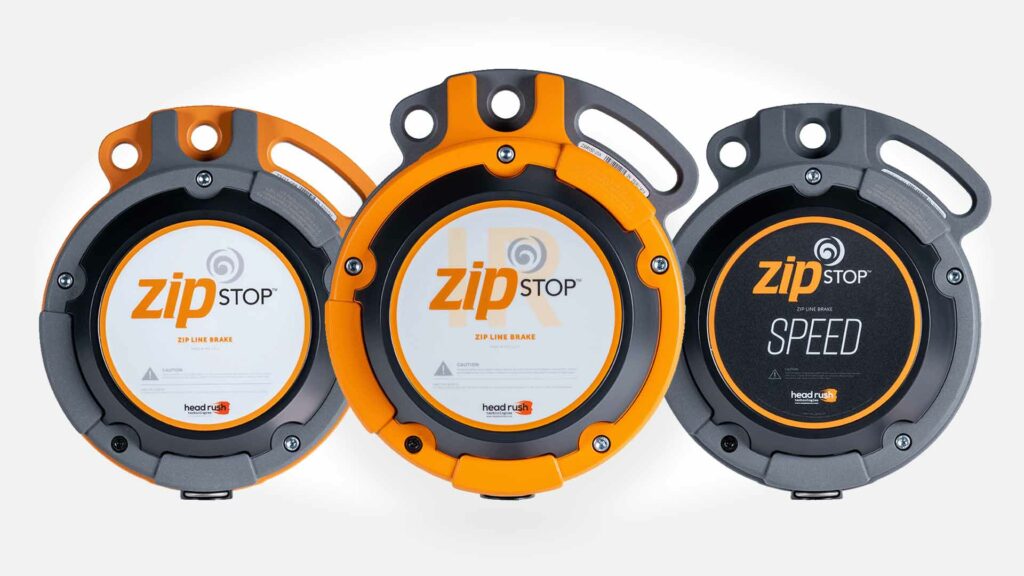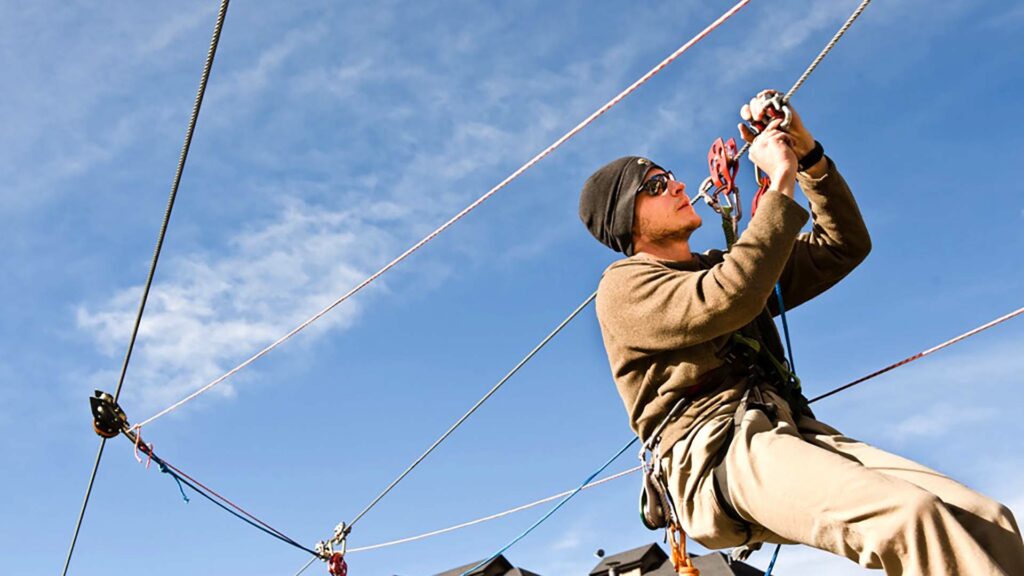All Head Rush Technologies’ zip line rider trolleys and redirection pulleys are built for maximum durability and minimal maintenance, and regular inspection is a critical step to ensure users get the maximum benefit of these products. This white paper is meant to supplement the user manuals for the LightSpeed Impact, EZ Clip, and Micro zip line trolleys and Head Rush Precision Redirection Pulley.
HOUSING INSPECTION
Deformation – All Head Rush trolley and pulley housings are made of aluminum for corrosion resistance and lightweight performance. Since aluminum is softer than many materials that the trolleys may be in contact with it is natural for the housings to wear over time. General scraping and wear of the anodization (colored surface treatment) is not a concern, however bending, deep gouging, and significant de- formation is a reason for retirement. Fast wear of the housing can be a sign of system incompatibility and should be assessed by a qualified person. This could be overspeed impacts in the braking zone, excessive swinging or movement during use, poor storage, or improper lanyards or connectors.
Head Rush often receives questions about the “mushrooming” or flattening of the primary and backup connector attachment points on the Micro Trolley, Impact Trolley, and Precision Pulley. Depending on the material and shape of the connector used this flattening can happen very rapidly, but generally subsides once the aluminum housing connection point matches the shape of the connector used. This process should be monitored and if it does not subside after initial onset the overall connection system and ride profile should be assessed by a qualified person.
Sharp edges – Any metal components that become sharp should be removed from service, as these edges could cause premature wear
and failure of textile components (such as redirect ropes, lanyards, and harnesses) that they come into contact with during use, transport, or storage. Inspect all trolley and pulley housing edges, inside and out, for wear that has led to sharpness. This wear could also be a sign of operational deficiencies or incompatibility of systems that may need to be inspected or modified by a qualified person.
Cracks – Any time a crack is found in a trolley or pulley housing that unit should be taken out of service. Due to variances in material and rides these can be isolated incidences, however, if this is an ongoing issue with multiple pieces of equipment the overall ride should be assessed by a qualified person. Generally, stress cracks will be seen propagating from housing edges, at tight bends, or from milled out features in the housing.
SHEAVES AND BEARINGS
LightSpeed Trolley bearings should be inspected before use to ensure riders stay within the operational envelope of the zip line. Excessively worn bearings can result in both high and low arrival speeds that may create operational delays, serious injury, or death. When a bearing is in good serviceable condition it will provide gentle resistance when spun by hand, minimal sound, and no lateral movement. If a hand spun sheave is excessively loud, feels “gritty”, or fails to freely move the trolley should be retired. If a sheave can be moved side to side within the housing or twisted out of plane that is also a sign of severe bearing degradation and it should be taken out of service. Sheaves should be free of sharp edges, corrosion, and have smooth load bearing surfaces. The sheaves of the LightSpeed Impact trolley are field replaceable with a genuine Head Rush sheave replacement kit.
The bearings in the Impact trolley are user replaceable with a genuine Head Rush sheave replacement kit, while the bearings in the EZ Clip and Micro Trolleys are not field serviceable.
The premium bearings in the Head Rush Precision Pulley cannot be serviced, and once worn to the point of retirement the pulley must be replaced. Seized bearings can create excessive friction in the braking system leading to poor performance as well as increased wear to other components in the system.
IMPACT SURFACE
All Head Rush zip line trolleys are designed for impact braking and have specially formulated surfaces to interact with zipSTOP Brake Trolleys. Inspection of this component consists of a visual check for missing sections, cracks, or excessive gouging.
While no immediate safety concerns are present if the impact surface is damaged, this will start to cause unnecessary and accelerated wear to the trolley housing and components of the brake system. For this reason, trolleys with damage to the impact surface should be repaired with genuine Head Rush Technologies replacement parts or replaced.
ATTACHMENT LINK
While most trolleys will use a third party connector to connect a participant, the LightSpeed EZ Clip has an integrated non-replaceable attachment link. This component should be inspected for excessive wear and proper gate function before use. If the gate fails to close and lock automatically it must be removed from service. The attachment link is surrounded by a polymer bushing, and as long as it is held snugly and pivots freely in this bushing it is fit for use. Damage to this bushing is generally the sign of an overload event and use should be evaluated. Do not attempt to disassemble or remove attachment link from trolley for inspection.
ACCESSORIES
Trolley accessories include the hook accessory (available for all zip line trolley models) and a handlebar accessory available for the EZ Clip and Impact Trolley models. The hook accessory is designed to minimize retrievals by interacting with the Head Rush Catch Accessory on a brake trolley and is visually inspected for corrosion or sharp edges.
The handlebar accessory for the EZ Clip is used solely for rider orientation and can be retired based on usability of the component. Corrosion, failure to properly deploy, or sharp edges may be reasons for retirement of this accessory.
The T-Handle on the Impact Trolley is installed by Head Rush Technologies at the factory and has an integrated attachment point for rider connection. See inspection and retirement criteria for “Trolley Housing” to assess the condition of this component.
REPLACEMENT PARTS
Never modify a Head Rush LightSpeed Trolley or Precision Pulley, and only replace components with genuine Head Rush replacement parts.
The Impact Trolley can be repaired in the field with a hook accessory, impact surface, and bearing/sheave replacement kits. The EZ Clip Handlebar Accessory is field installable and replaceable.
The LightSpeed EZ Clip and Micro Trolley impact surfaces, bearings, sheaves, and hook accessories are not field replaceable.
The Head Rush Precision Pulley has no user serviceable parts.
Conclusion
Regular inspection of all zip line equipment is a vital part of safe and effective operation. Consistent premature wear can be a sign of larger problems within a zip line system and may necessitate an evaluation of operational envelopes or compatibility of components within the system by a qualified person.



